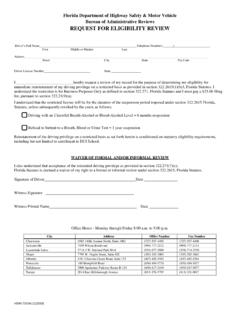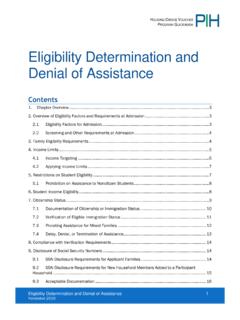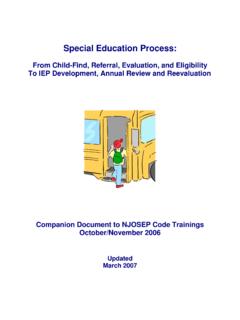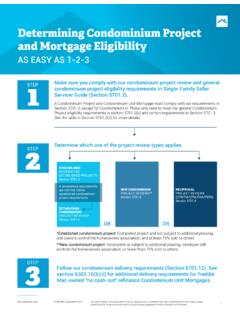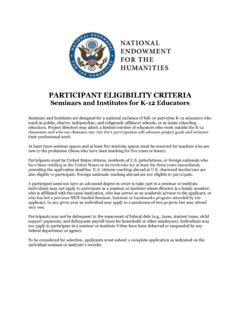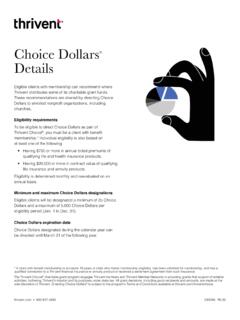Transcription of TENANT ELIGIBILITY REQUIREMENTS - USDA
1 TENANT ELIGIBILITY REQUIREMENTST opics to be covered Review of basic TENANT ELIGIBILITY REQUIREMENTS Income/Occupancy Waivers Occupancy Standards & ELIGIBILITY Student EligibilityBASIC TENANT ELIGIBILITY REQUIREMENTSB asic ELIGIBILITY REQUIREMENTS Applies to all Applicants Must be Income Eligible Cannot exceed the Moderate Income Limit as established by the Agency For current income limits, refer to the HUD User Website at: If applying for Rental Assistance, household cannot exceed the low income limit (80% of median income) Annual income and Adjusted income is still to be calculated in accordance to HUD Regulations (24 CFR & ) This was recently revised and will discuss in detail later on in this presentationBasic ELIGIBILITY REQUIREMENTS Meet the program definition of an eligible household Borrower must determine ELIGIBILITY for occupancy based on TENANT selection criteria as outlined in Management Plan Credit references, criminal background checks, landlord reference, etc.
2 Must be of legal age to enter into binding contract (Most States are 18 years) If Elderly Designated Complex TENANT or co- TENANT must be 62 years of age or disabled Must meet occupancy standards as established in Management Plan Tenants and Borrowers must execute an Agency approved TENANT certification form (3560-8) establishing TENANT s ELIGIBILITY {7 CFR (e)} If no TENANT certification or it has expired TENANT is not considered eligible and full Note Rate Rent will be charged If TENANT refuses to recertify proceed with termination of leaseINCOME/OCCUPANCY WAIVERSI ncome/Occupancy Waivers Applicable regulation: 7 CFR (d) Waivers may be granted for the following reasons: Income Ineligible Tenants TENANT will pay Full Note Rate Rent Failure of Household to meet occupancy standards (will cover later) TENANT s rent is still based on 30% of their adjusted income Waivers may NOT be granted for Age IneligiblesIncome/Occupancy Waivers Borrower must make request in writing to RD for waiver Following information must be provided Evidence that there are no eligible persons on waiting list Demonstrate that a diligent but unsuccessful effort to rent any vacant units to eligible TENANT household has been made.
3 May include advertisements, posting notices in public places, holding open houses, contacts to other housing agencies, real estate agencies, Waivers Borrower must agree to the following: Agree to continue to locate eligible tenants and retain copies of all marketing efforts Lease Agreement will not be for more than 12 months. After 12 months, it will become a month-to-month lease. Part X of TENANT Certification form should have the appropriate box checked indicating either Eligible or Granted an Income and/or Occupancy Waiver Must be transmitted via MINCI ncome/Occupancy Waivers RD may approve Waiver for temporary periods not to exceed 1 year for the entire complex (not TENANT specific) Once waiver is granted, no additional documentation is required to be submitted to RD during that period During this period, tenants would not be required to move if an eligible applicant becomes available on the waiting list Once waiver period has passed, ineligible TENANT will be required to move if eligible household becomes available RD will track this in MFIS under Servicing Efforts After 1 year, borrower will need to provide supporting documentation if waiver is still neededOCCUPANCY STANDARDSO ccupancy Standards Borrowers must define their occupancy standards in their Management Plan with the concurrence of Rural Development {7 CFR (e)}1.
4 Must include minimum and maximum number of people allowed in a unit of a particular size , For a 1 bedroom unit minimum of 1 person and a maximum of 2 people; 2 bedroom unit minimum of 2 people and a maximum of 4, Standards2. Procedures for assigning units the order in which eligible applicants and existing tenants will be housed or rehoused (7 CFR ) First priority existing tenants who are considered over-or under- housed if relocating them into the vacant unit would bring the household into compliance with the occupancy policy for the property If there are several occupancy ineligible tenants ( , 1 person in a 2 bedroom unit), the first household required to move would be the one whose lease expires first Second Priority waiting list, selected in the following order: Very low income applicants Low income applicants Moderate income applicantsOccupancy Standards3. The following would take priority over your normal occupancy standards {7 CFR (g)}: The applicant who requires the special design features of a unit accessible to individuals with disabilities The applicant has a Letter of Priority Entitlement (LOPE) Applicant must still meet ELIGIBILITY REQUIREMENTS The applicant was displaced from Agency-financed housing but was not issued a LOPE The applicant was displaced in a Federally declared disaster areaOccupancy address how fair housing REQUIREMENTS will be met, including how reasonable accommodations will be made for applicants and tenants with disabilities;HB-2-3560, Chapter 6, A states: A TENANT who is disabled will not be considered over housed if the TENANT requests an additional room for a live-in aide or an apparatus related to the TENANT s disability.
5 NOTE: Would be considered reasonable accommodation for 1 person household to live in a 2 bedroom unit if the TENANT obtains doctor s statement explaining their need for the additional bedroom. They would be considered eligible and no waiver would be Tenants At a minimum, the Management Plan should define what is considered over-and under-housed tenantsOver-Housed Tenants Tenants are considered over-housedif there are too many bedrooms for the number of people ( , 1 person in a 2 bedroom unit) This exact standard must be included in the Management Plan If no appropriately sized unit is available, TENANT must vacate if there is an eligible applicant on the waiting list within 30 days or at the end of their lease, whichever is greater Can make exceptions on a project by project basisOccupancy Policy Exception Complexes built with no 1 bedroom units may make an exception to this requirement in their occupancy policy {7 CFR (e)} Example: Complex only has 2 bedroom units and they have single applicants seeking housing.
6 They can change their Management Plan to state they will allow 1 TENANT households if no other eligible applicants are Tenants Tenants are considered under-housedif there are too many people for the number of bedrooms as specified in the occupancy standards , occupancy standards state that the maximum number of people that can reside in a 2 bedroom unit is 4 people and there are 5 people in the household Tenants in these situations should be offered the next available unit of the appropriate size prior to an offering it to the eligible applicant on the waiting list {7 CFR (c)} Can make exceptions on a project by project basisUnder-Housed Tenants Exceptions to under-housed: Superseded by State and Local occupancy codes Size of unit dictates that more people can reside in the unit (occupancy set by sq. ft. vs. number of bedrooms) 2 bedroom unit that has 900 sq. ft. might have room for more people than a 2 bedroom unit with 600 sq. Agreement Clauses Section II, 4 (g) Covers requirement for tenants who are determined to be over-housed and under-housed I understand that if the unit which I occupy becomes over-housed or under-housed under Landlord s occupancy rules, or should I no longer meet the ELIGIBILITY REQUIREMENTS of the housing complex during the term of the Lease, this Lease may be subject to termination in accordance with Section IV 1 (c) herein, or TENANT may, at Landlord s option, be required to move to Landlord s next available appropriately sized unit Lease Agreement Clauses Section IV, 1 (c) covers ineligible tenants: Non- ELIGIBILITY : The Landlord may terminate this Lease if the TENANT , although initially eligible, no longer meets the occupancy ELIGIBILITY REQUIREMENTS as to number of tenants under the housing project s or rental unit s applicable restrictions, including the criteria set forth in 7 (c) and (e).
7 TENANT agrees to vacate the rental unit within 30 days of Landlord s notice that TENANT is no longer eligible for occupancy, or at the expiration of the Lease, whichever is greater, unless the conditions cited in 7 (c) exist Occupancy Ineligible Tenants Handbook 2, Chapter 6, covers ineligible tenants due to occupancy issues The rules for relocating occupancy ineligible tenants depends on: Lease Agreement expiration Available applicants Appropriate size unitsWhat Would You Do? Scenario #1 TENANT is still in their 1 year lease as an occupancy ineligible TENANT (1 person in 2 bedroom unit) There are no eligible applicants needing a 2 bedroom unit on the waiting list There is an appropriately sized unit available for the ineligible TENANT to move intoAnswer Scenario #1 TENANT would not be required to move during the 1 year lease period Would recommend that the unit be offered and the TENANT move into the appropriately sized unit so they will become eligible If they choose not to move they are putting themselves in danger of being in a situation where an eligible applicant needs the occupied unit.
8 If that happens, the ineligible TENANT would be required to either move into an appropriately sized unit, if available, or vacate the propertyWhat Would You Do? Scenario #2 Occupancy ineligible TENANT s lease has expired and it has converted to a month-to-month lease There are no eligible applicants on the waiting list There is an appropriately sized unit for the ineligible TENANT to move intoAnswer Scenario #2 TENANT should be offered and move into the appropriately sized unit so they will become eligible If they do not move and an eligible applicant needs the occupied unit, the ineligible TENANT would be required to either move into an appropriately sized unit, if available, or vacate the propertyWhat Would You Do? Scenario #3 Occupancy ineligible TENANT s lease has expired and it has converted to a month-to-month lease Eligible applicant is on the waiting list needing the 2 bedroom unit Appropriate size unit is available for the occupancy ineligible TENANT to move intoAnswer Scenario #3 TENANT mustbe offered and move into the appropriately sized unit so they will become eligible If they do not move into the appropriately sized unit, borrower mustterminate the lease and the ineligible TENANT would be required to vacate the propertyWhat Would You Do?
9 Scenario #4 Occupancy ineligible TENANT s lease has expired and it has converted to a month-to-month lease Eligible applicant is on the waiting list needing the 2 bedroom unit Appropriate size unit is notavailable for the occupancy ineligible TENANT to move intoAnswer Scenario #4 Since there is no appropriately sized unit for the occupancy ineligible TENANT to move into, the only option this TENANT has is to vacate the property or the borrower will terminate the leaseOccupancy Ineligible Tenants There are only 2 instances where the household may continue to reside at the property after the lease has expired (with Agency approval) {7 CFR (c) (2)}: There are no eligible applicants on the waiting list (as discussed previously) The required time period (30 days) for vacating the unit would create a hardship on the household ( , need an additional 15 days to vacate, death in family, etc.) This is not permanent just an extension of time for the household to vacate Tenants would still be covered by their month-to-month lease and be required to vacate when eligible applicant is available to move inWho Pays TENANT s Moving Expense?
10 If a current TENANT is required to move into a suitably sized unit, who is required to pay for the moving expense? HB-3-3560, Chapter 10, Section 4, 2 states Tenants must agree to transfer to a correctly sized unit when one becomes available and must pay all costs associated with moving. RD Lease Agreement contains this provision (1stpage, 4thparagraph) Lease agreement gives option that landlord can pay this expense if agreed to in writingRelocating Tenants If a TENANT is moving into another unit, the following steps should be followed: Modify the TENANT Certification to show the new unit number. This may also affect the amount of rent they will be paying Do NOT need to re-verify income or transmit a new TENANT certification Revise the Lease Agreement to show the correct unit number, security deposit amount (if there is a change) and rent amount (changes must be initialed and dated by TENANT and management) Address security deposit amount based upon Management Plan ( , do you refund security deposit based upon the move-out inspection and recollect the new security deposit amount for the new unit; just collect the difference between the two units, etc.)


